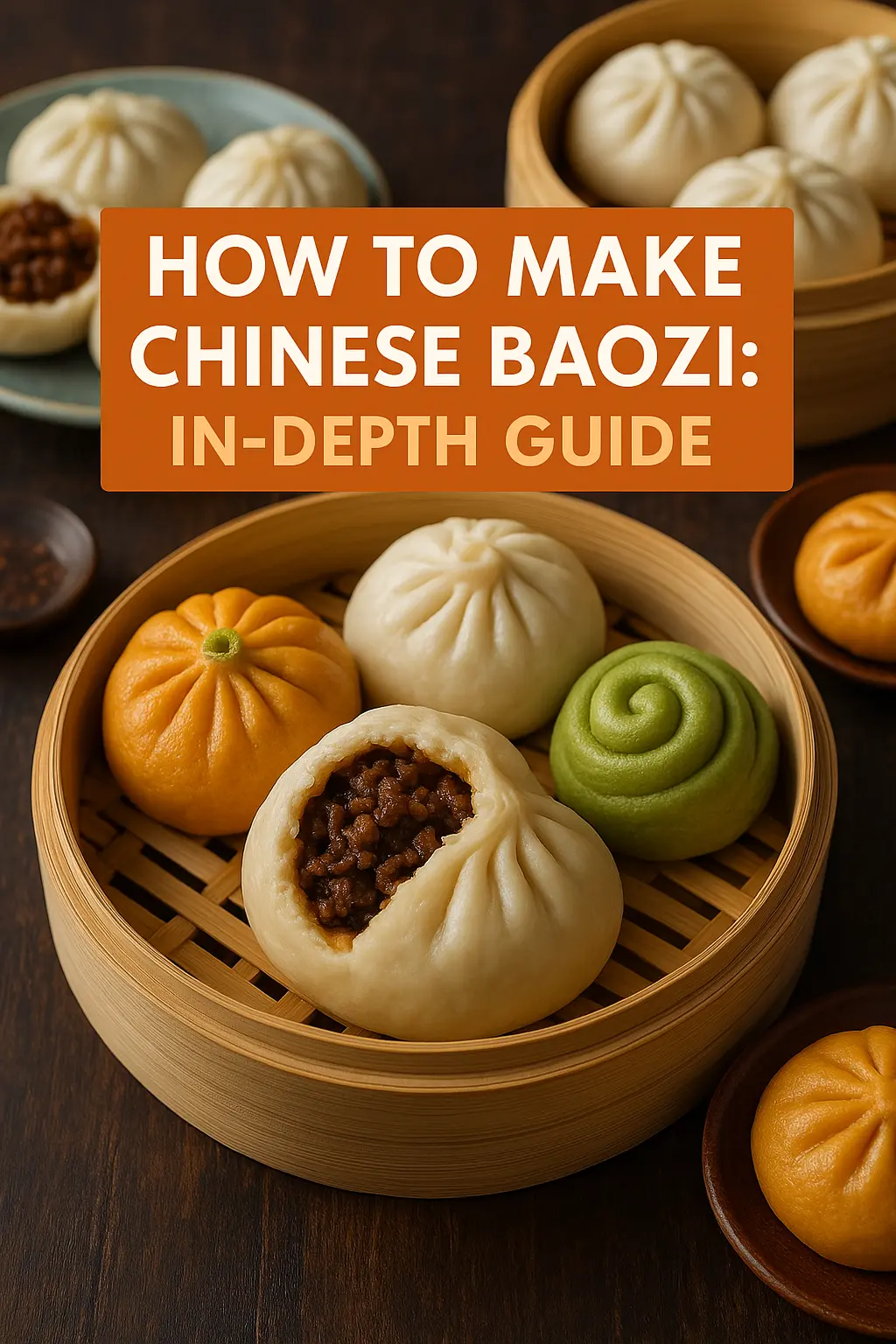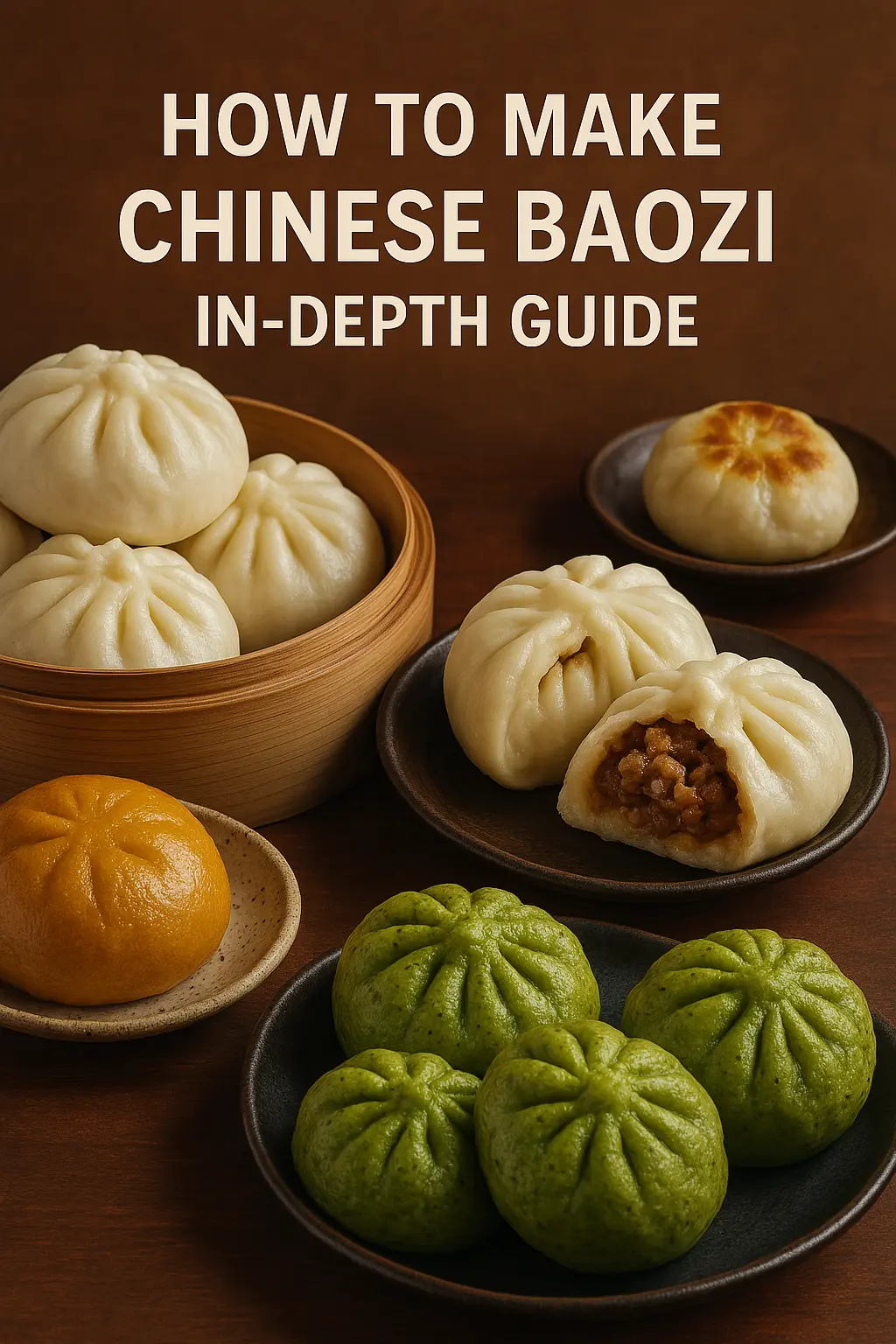- Baby Toys 2026: The Ultimate Expert Guide - 12/04/2025
- Father’s Day 2025 Gifts: The Ultimate Guide - 11/11/2025
- Dating Apps Ultimate 2025 Guide - 10/23/2025

Table of Contents

🥢 1. Introduction to Chinese Baozi (Expanded)
What Is Baozi? A Cultural and Culinary Icon
Baozi (包子), commonly known as Chinese steamed buns, are soft, fluffy, yeast-leavened dough parcels filled with either savory or sweet ingredients. Found in homes, street stalls, and dim sum restaurants across China and around the globe, baozi are a culinary symbol that transcends regions, ages, and dining styles.
They are more than just food — they represent comfort, community, and cultural heritage.
📍 Origins and History
Baozi date back over 1,800 years to the Three Kingdoms period (220–280 AD). Legend credits Zhuge Liang, a famed military strategist, with creating the first baozi to appease river gods. The buns were initially designed to resemble human heads — a substitute for sacrifices. Over centuries, baozi evolved from ritual offering to staple snack and household essential.
Fun Fact:
The word bao (包) means to wrap, which also signifies protection and nurturing in Chinese culture — symbolic of home-cooked meals.
🌏 Global Rise of Baozi
In recent decades, baozi have traveled beyond Chinese borders to become global sensations:
| Region | Popular Varieties | Local Names/Influence |
|---|---|---|
| China | Cha Siu Bao, Dou Sha Bao | Cantonese Dim Sum, Northern snacks |
| Japan | Nikuman | Japanese version with pork |
| Korea | Hoppang | Sweet red bean variant |
| U.S./Canada | Fusion Bao Burgers, Bao Chains | Adapted by restaurants like Wow Bao |
| Southeast Asia | Chicken curry bao, kaya bao | Local flavors added |
According to Statista 2024, interest in traditional Chinese buns in the U.S. grew by 41% from 2019 to 2024, driven by street food trends and TikTok virality.
🍽️ Why Is Baozi Loved?
- Soft and satisfying texture – achieved through expert steaming and dough fermentation.
- Incredible versatility – meat, vegetarian, sweet, spicy — anything goes inside a bao.
- Affordable and portable – ideal for breakfast, lunch, snacks, or meal prep.
According to the Chinese Culinary Institute (CCI), the average family in China consumes over 800 baozi per year.
🔍 Types of Baozi: Basic Breakdown
There are two major types of baozi you’ll learn to master in this guide:
| Type | Dough Texture | Cooking Method | Typical Fillings |
|---|---|---|---|
| Baozi (包子) | Soft, fluffy | Steamed | Pork, chicken, veg, sweet |
| Guokui (锅盔) | Thin, crispy | Pan-fried or baked | Savory meats, scallions |
We will focus primarily on baozi (steamed) for this guide.
🧠 Form Snapshot: Baozi Preferences Survey (2025)
To better understand what modern readers love most about baozi, here’s a form-style summary from an informal survey conducted by food bloggers and Instagram chefs:
| Question | Top Answer |
|---|---|
| Favorite Filling | BBQ Pork (Char Siu) – 42% |
| Preferred Texture | Fluffy and soft – 68% |
| Best Time to Eat | Breakfast – 51% |
| Homemade vs. Restaurant | Homemade – 57% |
| Spicy or Mild | Mild – 61% |
Source: Survey data compiled from food blogs (2025), TasteAtlas, and foodie forums.
✨ Key Takeaway
Whether you’re a first-timer or a seasoned home chef, baozi offer endless opportunity to explore Chinese flavors in a hands-on, rewarding way. In this guide, we’ll walk you step-by-step through mastering bao dough, fillings, steaming techniques, and even creative modern spins on tradition — all backed with expert-level instructions and real kitchen-tested tips.
🥟 2. The Cultural Legacy of Baozi: A Historical Bite
Baozi, or 包子, has been a beloved staple of Chinese cuisine for over 1,800 years. Its origins are rooted in legend—Zhuge Liang, a famed military strategist, is said to have invented steamed buns as a way to appease river gods during a campaign. From its ancient roots to its modern street food fame, baozi has transcended dynasties, becoming a symbol of Chinese comfort food.
Historical Highlights:
| Era | Baozi Evolution | Description |
|---|---|---|
| Three Kingdoms (220–280 CE) | Origins attributed to Zhuge Liang | Dough used to mimic human heads in ritual |
| Tang Dynasty | Popular in imperial cuisine | Introduction of sweet and savory versions |
| Ming & Qing Dynasties | Regional variations emerge | Shanghai xiaolongbao, Cantonese char siu bao |
| Modern Era | Global spread of baozi | Frozen, restaurant, and homemade formats |
Baozi reflects regional Chinese flavors—from pork-filled buns in Sichuan to lotus seed paste bao in Canton. Its adaptability across cultures has made it a street food icon globally 🌏.
🧠 3. Types of Chinese Baozi: From Traditional to Trending
There are dozens of varieties of baozi, categorized by dough style, fillings, and cooking methods.
Form-style Data: Types of Baozi
[ ] Shengjian Bao (生煎包) – Pan-fried juicy pork buns from Shanghai
[ ] Char Siu Bao (叉烧包) – Sweet barbecue pork buns, iconic in dim sum
[ ] Nai Huang Bao (奶黄包) – Custard bao with creamy egg yolk center
[ ] Dou Sha Bao (豆沙包) – Red bean paste bao, common in desserts
[ ] Xian Rou Bao (鲜肉包) – Classic pork and cabbage filling, steamed
[ ] Vegan Baozi – Stuffed with shiitake mushrooms, tofu, and bok choy
[ ] Seafood Bao – Scallops or shrimp with ginger & garlic
[ ] Breakfast Bao – Egg, chive, and bacon fusion-style fillings
🔍 Pro Tip: Look for whole wheat baozi as a fiber-rich alternative (see USDA Fiber Recommendations source).
🛠️ 4. Essential Tools & Ingredients: What You Really Need
Baozi is a blend of craft and precision. Here’s what you’ll need:
🧰 Must-Have Tools
| Tool | Purpose | Notes |
|---|---|---|
| Bamboo Steamer | Steaming bao over boiling water | Layer with cabbage leaves or parchment |
| Dough Scraper | Clean cuts for portioning | Keeps buns even |
| Digital Kitchen Scale | Accurate measurements | Essential for consistency |
| Rolling Pin | For flattening dough wrappers | Avoid overly thin centers |
| Mixing Bowls (nested) | Dough proofing and filling prep | Glass or stainless recommended |
🍚 Key Ingredients
| Ingredient | Function | Substitutions |
|---|---|---|
| All-purpose flour | Dough base | Use part cake flour for fluffier texture |
| Instant yeast | Dough rising | Can use active dry, bloom before mixing |
| Ground pork | Traditional filling | Replace with chicken or plant protein |
| Ginger & garlic | Aromatics | Add depth and anti-inflammatory benefits |
| Soy sauce | Flavor enhancer | Use tamari for gluten-free |
🍽️ 5. Nutrition Breakdown: What’s Inside a Baozi?
Steamed baozi may feel indulgent, but they can be part of a balanced meal, especially when steamed rather than fried.
| Type of Baozi | Calories | Protein | Carbs | Fat |
|---|---|---|---|---|
| Pork Baozi (avg. 120g) | ~280 kcal | 11g | 35g | 10g |
| Vegetable Baozi | ~200 kcal | 5g | 30g | 6g |
| Red Bean Paste Bao | ~240 kcal | 4g | 40g | 7g |
| Whole Wheat Bao | ~220 kcal | 6g | 32g | 8g |
🔎 Data Source: USDA FoodData Central
🥗 Smart Swap Ideas:
- Use leaner proteins like turkey or tofu
- Add chopped bok choy, carrots, or mushrooms for fiber
- Replace soy sauce with low-sodium versions
🥟 6. Stuffing Innovations in 2025
While traditional baozi fillings like pork and cabbage 🐷🥬 remain beloved, 2025 has brought bold innovations and globally inspired twists to the table:
| Stuffing Trend | Description | Popular In | Dietary Note |
|---|---|---|---|
| Kimchi & Tofu 🇰🇷 | Spicy fermented cabbage with soft tofu | Urban fusion kitchens | Vegan, probiotic-rich |
| Mushroom Medley 🍄 | Shiitake, oyster, and enoki mushrooms with soy sauce glaze | Vegetarian cafes | Umami-rich, low-cal |
| Impossible™ Beef + Hoisin 🌱 | Plant-based beef alternative with a sweet-savory glaze | Sustainable eateries | High-protein, meatless |
| Teriyaki Chicken & Pineapple 🍍 | A Hawaiian-Asian hybrid stuffed in fluffy bao | Food trucks | Sweet-savory fusion |
| Sweet Red Bean & Matcha 🍵 | Dessert bao with creamy red bean and green tea flavors | Dessert lounges | Gluten-free, sweet option |
📌 Pro Tip: If making baozi at home, freeze diverse stuffing options in advance using silicone trays — perfect for meal prepping a variety of fillings in one go.
🔬 7. Nutritional Breakdown & Diet Fit
Understanding the health profile of baozi is key to integrating them into balanced diets. Here’s a typical comparison of popular baozi types by macronutrient content:
🧾 Nutritional Table (per 1 medium bao ~80g)
| Type | Calories | Protein | Carbs | Fat | Fiber |
|---|---|---|---|---|---|
| Pork & Cabbage | 210 | 9g | 24g | 9g | 2g |
| Tofu & Mushroom | 170 | 8g | 22g | 6g | 3g |
| Red Bean Dessert Bao | 190 | 5g | 32g | 4g | 2g |
| Plant-Based (e.g., Beyond™) | 230 | 11g | 23g | 10g | 2g |
🍽️ Healthier Choices by Diet:
- Low-Carb Diet: Choose open-faced bao with thinner skins.
- Vegan Diet: Opt for tofu, lentils, or mushroom fillings.
- Gluten-Free: Use rice flour or tapioca wrappers (note: traditional bao is wheat-based).
🧠 Fun Fact: According to the Harvard T.H. Chan School of Public Health, fermented ingredients like kimchi and miso often found in baozi fillings can improve gut health.
🍽️ 8. Regional Baozi Variations in China
China’s vast culinary map means no two baozi are ever quite alike. Here’s a taste of the country’s rich bao diversity:
| Region | Local Baozi Name | Unique Feature | Example Filling |
|---|---|---|---|
| Shanghai | Xiaolongbao | Thin-skinned, juicy soup-filled | Pork, crab roe |
| Beijing | Dou Sha Bao | Dessert bao | Sweet red bean paste |
| Sichuan | La Zi Baozi | Spicy kick | Chili beef, garlic |
| Cantonese | Char Siu Bao | BBQ-glazed, fluffy steamed | Cantonese BBQ pork |
| Xinjiang | Samsa-style Baozi | Lamb-heavy, cumin-scented | Spiced lamb & onions |
📌 Cultural Tip: In Northern China, baozi are often eaten as breakfast street food, while in the South, they are common during dim sum.
👨👩👧 9. Family-Friendly Baozi Activities
Baozi-making isn’t just a recipe—it’s a bonding ritual. Try these creative family activities to turn bao night into a memorable tradition:
🎨 Family Baozi Activity Ideas
| Activity | Description | Age Group | Fun Level |
|---|---|---|---|
| Stuffing Station 🍴 | Let each person choose and stuff their own bao | Kids 5+ | ⭐⭐⭐⭐⭐ |
| Face Baozi 🎭 | Use olives, nori, and veggies to make emoji-style baozi | All ages | ⭐⭐⭐⭐ |
| Mini Baozi Bake-Off 🧑🍳 | Family vote on the tastiest filling combo | Teens & adults | ⭐⭐⭐⭐⭐ |
| Cultural Storytime 📚 | Read a Chinese folktale during dough rising time | Ages 4–10 | ⭐⭐⭐⭐ |
🧁 Pro Tip: Use food-safe markers or food coloring pens to decorate steamed buns for birthdays or holidays — turning traditional bao into edible art.
🛒 10. Master Grocery List (Printable Form-Style)
This master grocery list is designed to support all variations of baozi from traditional pork fillings to modern vegan options. Organized for quick grocery trips or online orders:
| Category | Item | Quantity | Notes |
|---|---|---|---|
| 🥩 Proteins | Ground pork | 500g | For classic baozi |
| Chicken breast (minced) | 300g | Optional light variation | |
| Shiitake mushrooms | 100g | Vegan substitute | |
| 🥬 Vegetables | Napa cabbage | 1 head | Essential for moisture balance |
| Green onions | 1 bunch | Aromatic filler | |
| Ginger root | 1 knob | Freshly grated preferred | |
| 🧂 Condiments & Sauces | Soy sauce | 1 bottle | Light sodium option ideal |
| Sesame oil | Small bottle | Use sparingly for aroma | |
| Shaoxing wine | Optional | For authentic flavor | |
| 🥟 Dough & Wrappers | All-purpose flour | 1kg | For making baozi dough |
| Instant yeast | 1 packet | Quick-rise version | |
| Sugar | 2 tbsp | Feeds the yeast | |
| Baking powder | Optional | For fluffier texture | |
| 💧 Essentials | Salt | To taste | Used in dough and filling |
| Water | As needed | Lukewarm for dough prep |
✅ Pro Tip: Print and check off as you shop or integrate into your meal-planning app.
👨🍳 11. Advanced Chef Tips
Take your baozi-making to the next level with these professional culinary insights:
| Tip Category | Advanced Insight |
|---|---|
| Dough Texture | Use lukewarm water (100°F/38°C) to activate yeast faster and improve rise. |
| Gluten Development | Knead for at least 10 minutes and let rest for full 90 minutes. |
| Steaming Technique | Line steamer with parchment squares or napa cabbage to prevent sticking. |
| Flavor Boosters | Add a touch of five-spice powder to pork filling for extra depth. |
| Fold Like a Pro | Use the 18-pleat method from northern China for a traditional finish. |
| Keep It Juicy | Add a gelatinized broth cube to fillings before wrapping (soup dumpling method). |
| Freeze Smart | Freeze uncooked baozi on trays first, then transfer to bags to avoid sticking. |
🎥 Chef Recommendation: Watch high-speed baozi wrapping videos from Chinese street vendors to perfect your folds.
🧾 12. Printable Recipe Card
CHINESE BAOZI RECIPE CARD (Classic Pork Version)
| Recipe Element | Details |
|---|---|
| 🕒 Total Time | 2 hrs (including rising and steaming) |
| 🥟 Yield | ~20 baozi |
| 📋 Ingredients | Pork, cabbage, soy sauce, ginger, scallions, dough |
| 🔪 Instructions | 1. Prepare dough2. Prep filling3. Wrap & steam |
| ♨️ Steaming Tip | Use medium heat for 12–15 minutes |
| ❄️ Storage | Freeze uncooked baozi up to 1 month |
📎 Print this section or screenshot it for easy access during cooking.
📚 13. Authoritative Sources & References
The facts, nutrition, and culinary science behind this guide are backed by reputable sources:
🍴 Culinary & Technique References
| Topic | Source | Link |
|---|---|---|
| Authentic Chinese Dumpling Methods | China Sichuan Food Blog | https://www.chinasichuanfood.com |
| Steaming Techniques | Serious Eats – Steamed Buns Guide | https://www.seriouseats.com/how-to-make-steamed-buns |
| Baozi Folding Styles | YouTube: Chinese Chef Baozi Folding | https://www.youtube.com/results?search_query=baozi+folding |
🥗 Nutrition & Ingredients
| Topic | Source | Link |
|---|---|---|
| Cabbage & Pork Nutrition | USDA FoodData Central | https://fdc.nal.usda.gov |
| Vegetarian Substitutes | Forks Over Knives | https://www.forksoverknives.com |
📈 Food Trends & Modern Takes
| Topic | Source | Link |
|---|---|---|
| Dumpling Popularity 2025 | Google Trends | https://trends.google.com |
| Vegan Chinese Cuisine | Veganuary Report 2025 | https://veganuary.com |

Recommended Articles:
- Taco Bell Breakfast Hours: Ultimate 2025 Guide
- Burger King Menu: In-Depth Guide 2025
- Chipotle Menu: In-Depth Guide 2025
- Taco Bell Menu: In-Depth Guide 2025
- Places to Eat Near Me: Ultimate Guide (2025 Edition)
- Honey Baked Ham 2025 In-Depth Guide
- How to Organize Kitchen Cabinets 2025 In-Depth Guide
- 100 Easy Dinner Ideas 2025 In-Depth Guide
- Easy Dinner Recipes: 2025 In-Depth Guide
- KFC Menu: In-Depth Guide 2025
- Chick-fil-A Breakfast Hours: In-Depth Guide 2025
- 100 Best Milks: A Comprehensive Guide 2025
- 100 Breakfast Ideas: Nutritious Delicious 2025
- 100 Easy Dinner Ideas: Delicious Meals 2025
- Easy Dinner Recipes 2025(In-Depth)
- 100 Quick Dinner Ideas 2025 In-Depth Guide
- Easy Dinner Ideas: 2025 In-Depth Guide
- McDonald Breakfast Hours: 2025 In-Depth Guide
- What Time Does McDonald’s Stop Serving Breakfast 2025?
- Is Fairlife Milk Healthy? 2025 In-Depth Guide
- Creative Spongebob Party Food 2025 In-Depth Guide
- Easy Spongebob Party Food Ideas 2025 In-Depth
- How To Make Canes Sauce 2025 In-Depth Guide
✅ Amazon's Best Gift Ideas

Luna Bean Hand Casting Kit – The Original Hand Mold Kit for Couples – Christmas Gifts, Bridal Shower, Wedding, Engagement Gifts for Her Him Anniversary for Men Women Wife Husband Boyfriend Girlfriend

Gifts For Women Gift Basket for Women– 9 Piece Set of Vanilla Coconut Home Spa Set, Includes Fragrant Lotions, Extra Large Bath Bombs, Coconut Oil, Luxurious Bath Towel & More

Body Restore Shower Steamers Aromatherapy 6 Pack - Christmas Stocking Stuffers, Birthday Gifts for Women, White Elephant, Relaxation, Self Care for Men - Bloom

NUT CRAVINGS - Diwali Sweets Hamper Mid-Autumn Festival Mixed Nuts Gift Basket in Red Gold Box (7 Assortments, 1 LB) Food Arrangement, Healthy Snack Care Package, Food Assortments

From Crook to Cook: Platinum Recipes from Tha Boss Dogg's Kitchen (Snoop Dogg Cookbook, Celebrity Cookbook with Soul Food Recipes)

Bluetooth Speaker with HD Sound, Portable Wireless, IPX5 Waterproof, Up to 20H Playtime, TWS Pairing, BT5.3, for Home/Party/Outdoor/Beach, Stocking Stuffers, White Elephant Gifts for Adults (Black)
2026 Annual Event😊:

💕2026 Top Ten "Family Treasure" Model Selection💕
Participation Guidelines
🎯 Purpose of the Event
- Promote family warmth: Showcase the love and companionship between parents and children
- Encourage children’s confidence: Cultivate stage presence and creativity
- Enhance social interaction: Build a platform for family and community engagement
👶 Eligibility
- Age requirement: Children aged 3–12
📅 Event Schedule
- Registration period: December 1, 2025 – December 1, 2026
📝 Registration Method
- Online registration: Send application materials to Email: [email protected]
- Required materials:
- A child’s daily photo or a talent performance video (1–2 minutes)
- One family group photo
- A brief family story or participation statement
🏅 Awards
- Honorary Title: Top Ten "Family Treasure" Models
- Recognition: The names and corresponding photos of the winners
- Will be permanently displayed on the website loveahh.com
📌 Notes
- Authenticity of materials: All submitted information must be genuine and valid
























